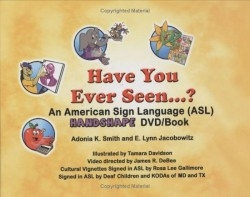Have You Ever Seen...?
An American Sign Language Handshape DVD/Book
In this first in a series, Smith and Jacobowitz present forty-four of the most common ASL handshapes in an engaging mix of text and full-color graphics, including a DVD. The authors are co-founders of ASL Rose, creator, publisher, and distributor of ASL-English bilingual materials, and their mission is to familiarize the student with deaf culture while teaching the language of that culture. This “DVD/Book” is dedicated to K-12 students, but the content and degree of difficulty of the text (signed on the DVD) that accompanies each handshape lesson make this package most suitable for learners in upper grade levels. The DVD is especially relevant, since ASL relies heavily on changes in bodily movement and facial expressions to convey emotion, emphasis, and other aspects of language. Learners will notice, for example, that signers on the DVD, and in the world of ASL, lean forward when asking a question.
Each of the handshapes is used in a “Have you ever seen … ?” question that is illustrated in an animated-sequence graphic. “Have you ever seen an owl knowing nothing?” is an example using the handshape “O,” which is formed by the circle shape of thumb and forefinger.
Learners soon realize that the ASL signing for “owl” is similar to the signing for “knowing nothing.” In their introduction, the authors point out that ASL repetitions, or “ASL rhymes,” are visually attractive to deaf readers, just as English language rhymes and alliterations are auditorially pleasing to those who can hear them. The graphic accompaniment for the phrase, “owl knowing nothing” shows an owl, in a Phi Kappa Zeta sorority t-shirt, sitting in a tree. The trunk of this tree has been carved with initials and the claim, “George Veditz was here!” The owl uses the O handshape to sign “owl” in the first half of the sequence and then “knowing nothing” to complete the question. Red arrows in each illustration signify the all-important hand movements. The text for the handshape explains that Phi Kappa Zeta is the oldest deaf sorority at Gallaudet University, the world’s only liberal arts university strictly for deaf people. And the initials are those of George Veditz and his wife, who met as students at Gallaudet. Veditz was a president of the National Association of the Deaf who championed ASL and deaf culture.
Some other of the forty-four catchy ASL rhymes that teach handshapes and introduce deaf culture include “a gorilla acting,” “a mouse brushing her teeth,” “a kangaroo who is a pirate,” and “an egg wearing a necktie.”
Students will enjoy these seemingly nonsensical pairings as they learn how each item in the pair is related by its handshape. They will also enjoy the inside jokes, customs and traditions of the deaf culture that are included. For example, many students at Gallaudet sneak up into the famous “Tower Clock” on campus to write their names. ASL is “the core of Deaf Culture,” and here ASL Rose delivers both language and culture to the ASL-English bilingual.
Reviewed by
Joe Taylor
Disclosure: This article is not an endorsement, but a review. The publisher of this book provided free copies of the book and paid a small fee to have their book reviewed by a professional reviewer. Foreword Reviews and Clarion Reviews make no guarantee that the publisher will receive a positive review. Foreword Magazine, Inc. is disclosing this in accordance with the Federal Trade Commission’s 16 CFR, Part 255.

